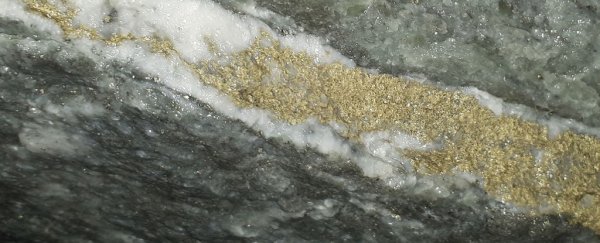Gold, for all its wonderful uses, isn't hugely abundant in Earth's upper layers. For each ton of crust material, there's an estimated just 0.004 grams of the precious metal.
Yet somehow, there are regions that contain "bonanza" abundances - hyper-enrichment, in the scientific parlance. How these gold veins form in time spans as short as days from hydrothermal systems that only contain trace amounts of the metal has been a geological mystery.
It's one that now has an answer, from the most unlikely of clues: the separation and clumping of fat particles in soured milk.
"Scientists have long known that gold deposits form when hot water flows through rocks, dissolving minute amounts of gold and concentrating it in cracks in the Earth's crust at levels invisible to the naked eye," geoscientists Anthony Williams-Jones and Duncan McLeish of McGill University in Canada stated in a Q&A.
"In rare cases, the cracks are transformed into veins of solid gold centimetres thick. But how do fluids with such low concentrations of gold produce rare ultrahigh-grade gold deposits? Our findings solve the paradox of 'ultrahigh-grade' or 'bonanza' gold formation, which has frustrated scientists for over a century."
Milk is an aqueous solution made up of several components, one of which is microscopic globules of fat. At the pH level of fresh milk - very close to neutral - these fat particles have a negative charge, which causes them to repel each other.
The souring process involves bacteria in the milk converting lactose to lactic acid, lowering the pH level accordingly. This causes the surface charge on the fat particles to break down, and the fat particles separate from the milk serum and clump together with each other via coagulation, forming a sort-of gross decomposing milk fat jelly.
Williams-Jones, McLeish and their colleagues found a similar process when using transmission electron microscopy to study gold deposits from the Brucejack Mine in British Columbia. This is one of the spots around the world where bonanza-grade mineralization can be found, up to 41,582 grams per ton.
It's long been accepted that gold is transported by way of fluid through Earth's crust. However, in order to reach the abundances found in hyper-enrichment zones, previous studies suggested that the gold may have been dissolved in high concentrations in fluids containing chlorides or bisulfides, and transported and deposited that way.
The other possibility is a colloidal solution, with solid nanoparticles of gold dispersed throughout hydrothermal and geothermal fluids. Since the gold nanoparticles hold a charge (like milk fat), they repel each other. When the charge breaks down, the gold particles clump together in a process similar to coagulation, known as flocculation.
This has been indirectly demonstrated in the past; now, McLeish and colleagues have observed how it actually happens.
"We produced the first evidence for gold colloid formation and flocculation in nature and the first images of small veins of gold colloid particles and their flocculated aggregates at the nano-scale," Williams-Jones and McLeish said.
"These images document the process by which the cracks are filled with gold and, scaled up through the integration of millions of these small veins, reveal how bonanza veins are formed."
For this process, the concentration of gold in the geothermal fluids only has to be a few parts per billion. It flocculates to form a jelly-like substance, which gets trapped in cracks in Earth's crust to form rich gold veins.
This finding suggests that rich gold deposits may be more common than we thought, and may have occurred in several other contexts than previous estimates had allowed for. If other studies and further examination can back it up, the research could give us a new toolkit for understanding and locating gold deposits around the world.
"We suspect that the colloidal processes that operated at Brucejack and other bonanza gold systems may also have operated to form more typical gold deposits. The challenge will be to find suitable material to test this hypothesis," Williams-Jones and McLeish said.
"The next step will be to better understand the reasons why colloid formation and flocculation occurred on the scale observed and reconstruct the geological environment of these processes."
The research has been published in PNAS.
